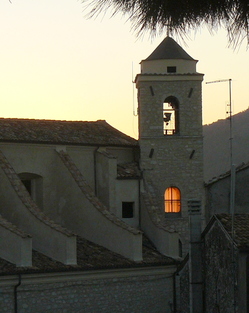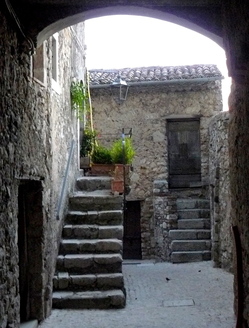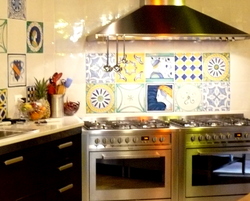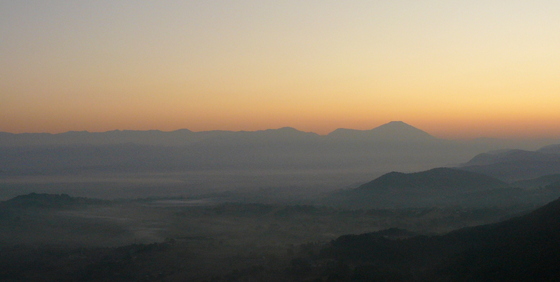CASTRO DEI VOLSCI, Italy--Welcome news on the travel front: Casa Gregorio, a bed & breakfast and cooking school here in the countryside south of Rome, is bringing style and vitality to this perfectly restored medieval village.
 This area, known as the Ciociaria, is a long valley between Rome and Naples, hemmed in by steep, forest-covered hills (the Apennines--Italy's spine--to one side, a coastal range to the other) and saw some of the heaviest fighting during World War Two at Monte Cassino. (In the shameful aftermath of the Allied victory, renegade Morroccan troops pillaged the countryside; Vittorio De Sica's movie Two Women, with Sophia Loren's Oscar-winning role as the mother of a brutalized teenager, was called La Ciociara in Italian.)
This area, known as the Ciociaria, is a long valley between Rome and Naples, hemmed in by steep, forest-covered hills (the Apennines--Italy's spine--to one side, a coastal range to the other) and saw some of the heaviest fighting during World War Two at Monte Cassino. (In the shameful aftermath of the Allied victory, renegade Morroccan troops pillaged the countryside; Vittorio De Sica's movie Two Women, with Sophia Loren's Oscar-winning role as the mother of a brutalized teenager, was called La Ciociara in Italian.)
The Ciociaria is often overlooked by travelers drawn the romance of Tuscany, to the north, or the glamour of the Amalfi Coast, to the south. In fact, the corridor is traversed by the A1 motorway; Italy's fastest train, the Frecciarossa, makes the 150-mile run between Rome and Naples down the center of the Ciociaria, in a just over an hour. Yet the Ciociaria was named an area of national interest for its panoramic views and fine food.
 Castro dei Volsci--the stronghold of the Volsci clan back in the 15th and 16th centuries--sits atop one of the hills overlooking the valley. The village itself is a meticulously restored community of 300 or so inside the walls and a couple thousand folks who live on surrounding farms. A minibus comes up from the valley several times a day; private cars park outside the walls. There's a post office, a bakery, a couple of shops and cafes, and then there's Casa Gregorio, which combines a taverna for the locals (open weekends for now, soon to open daily), a professional kitchen, elegantly appointed living quarters and five luxurious guest rooms with private baths.
Castro dei Volsci--the stronghold of the Volsci clan back in the 15th and 16th centuries--sits atop one of the hills overlooking the valley. The village itself is a meticulously restored community of 300 or so inside the walls and a couple thousand folks who live on surrounding farms. A minibus comes up from the valley several times a day; private cars park outside the walls. There's a post office, a bakery, a couple of shops and cafes, and then there's Casa Gregorio, which combines a taverna for the locals (open weekends for now, soon to open daily), a professional kitchen, elegantly appointed living quarters and five luxurious guest rooms with private baths.
It's taken Gregory Aulensi three years to restore the property, which, ironically, he never set out to purchase. A successful decorator in Florida, he had decided to move to Rome in search of a simpler life. His father, though, had been born in Castro dei Volsci, and one day Gregory returned to the village for a wedding. The property next door to his father's house happened to be for sale: an interconnected series of houses, workshops and terraces built into the village walls, 12,000 square feet in all. The price was no more than a studio apartment in Rome, so, in the Italian tradition of spontaneity, Gregory made the life-changing decision to buy it.
 Now he's offering cooking classes in a perfectly equipped kitchen to his B&B guests, who also get his personal attention throughout their six-night programs. You don't need a car of your own; Gregory's vehicles are comfortable sedans and minivans. You don't need to be a professional chef, either; the local women who come in to demonstrate pasta-making or vegetable carving are patient to a fault. Visits to a vineyard and an olive mill are part of the program as well. And if you happen to be there over a weekend, you can stop in at the agriturismo at the bottom of the hill, Il Rusponte, and enjoy the copious farmhouse lunch we described in a post back in October.
Now he's offering cooking classes in a perfectly equipped kitchen to his B&B guests, who also get his personal attention throughout their six-night programs. You don't need a car of your own; Gregory's vehicles are comfortable sedans and minivans. You don't need to be a professional chef, either; the local women who come in to demonstrate pasta-making or vegetable carving are patient to a fault. Visits to a vineyard and an olive mill are part of the program as well. And if you happen to be there over a weekend, you can stop in at the agriturismo at the bottom of the hill, Il Rusponte, and enjoy the copious farmhouse lunch we described in a post back in October.
Gregory has launched an ambitious cultural heritage program for "his" village, which has even attracted the attention of Italy's RAI television network. The video is here, picturesque scenery, muddy buffalo herd, cooking class and all, though it's in Italian.
Bookings through The International Kitchen, which made arrangements for my visit.

Leave a comment